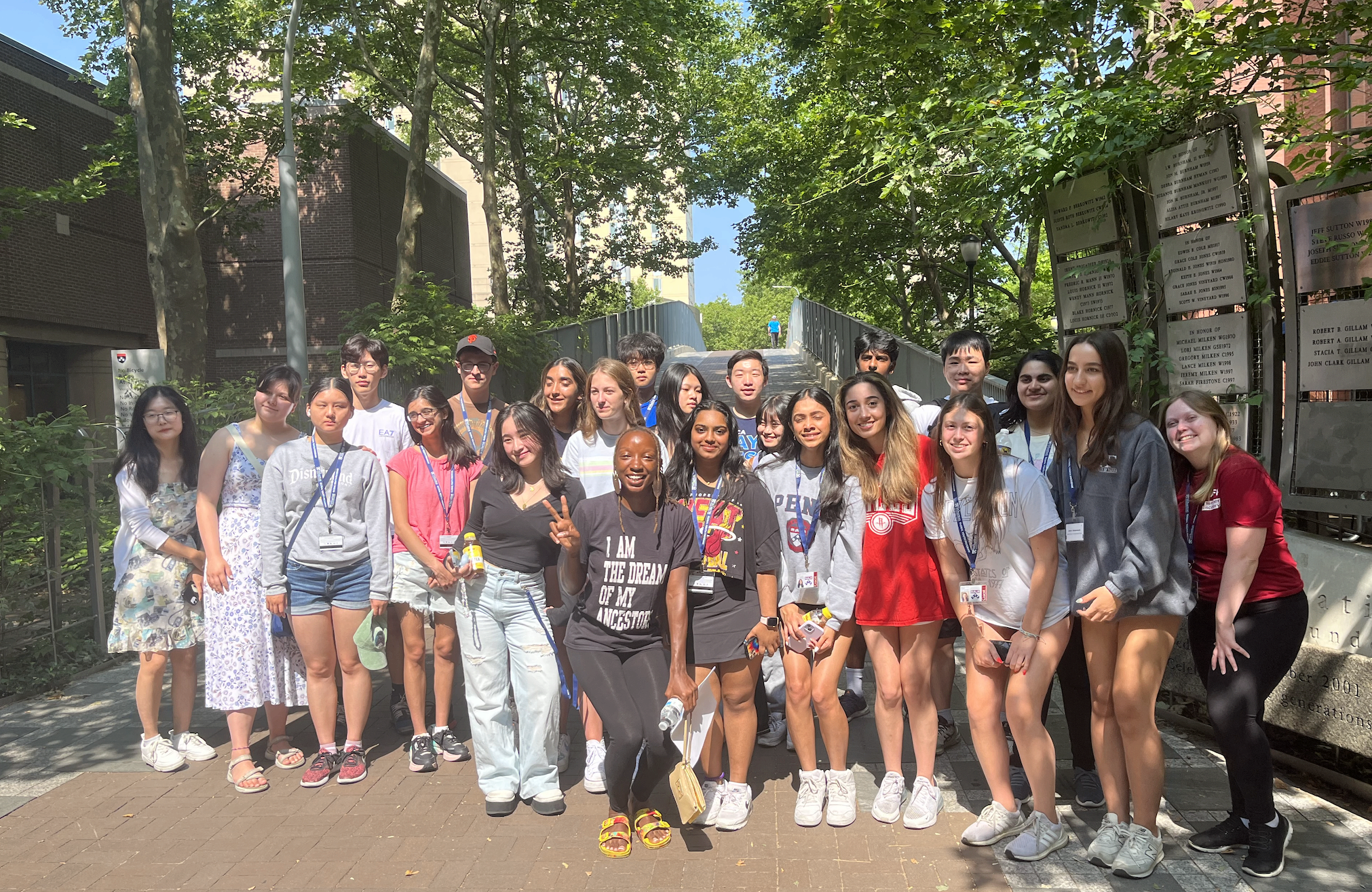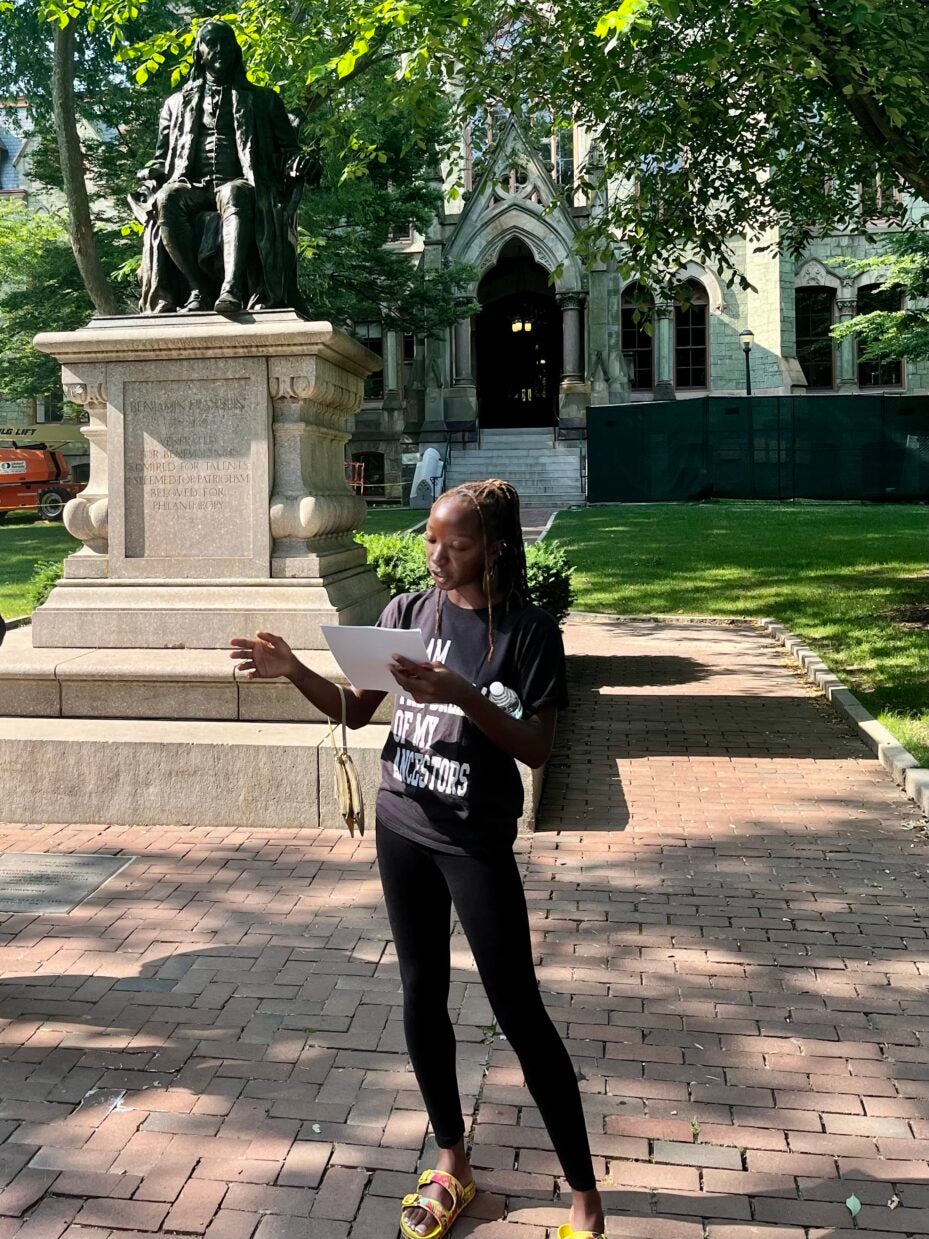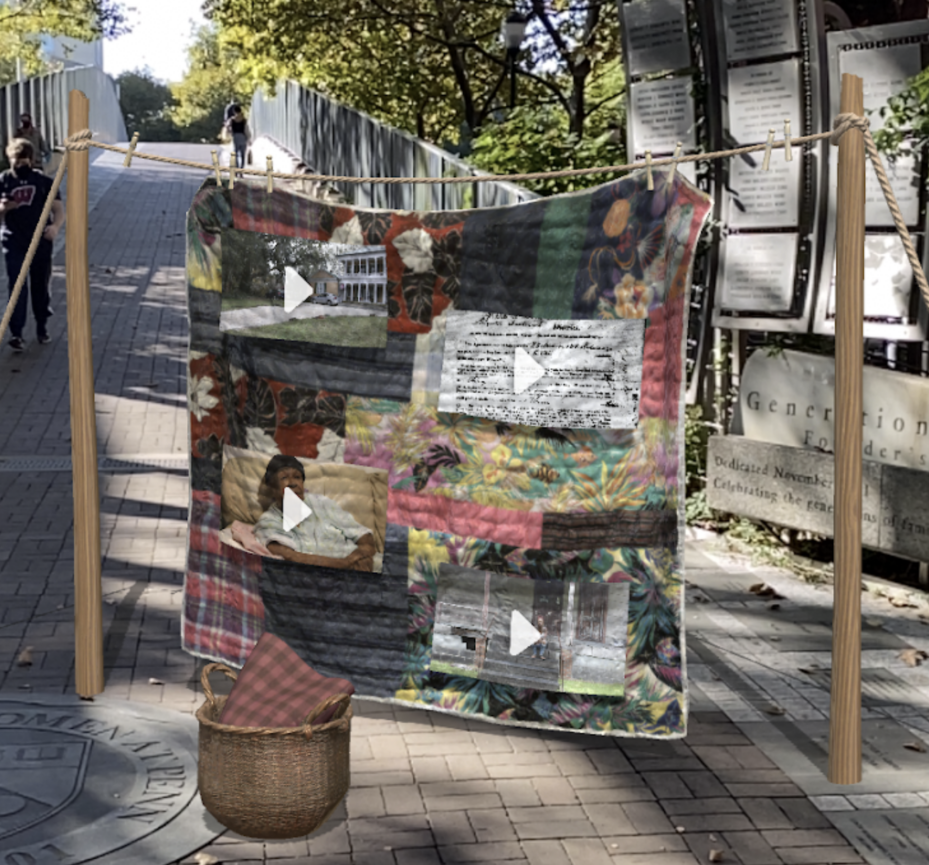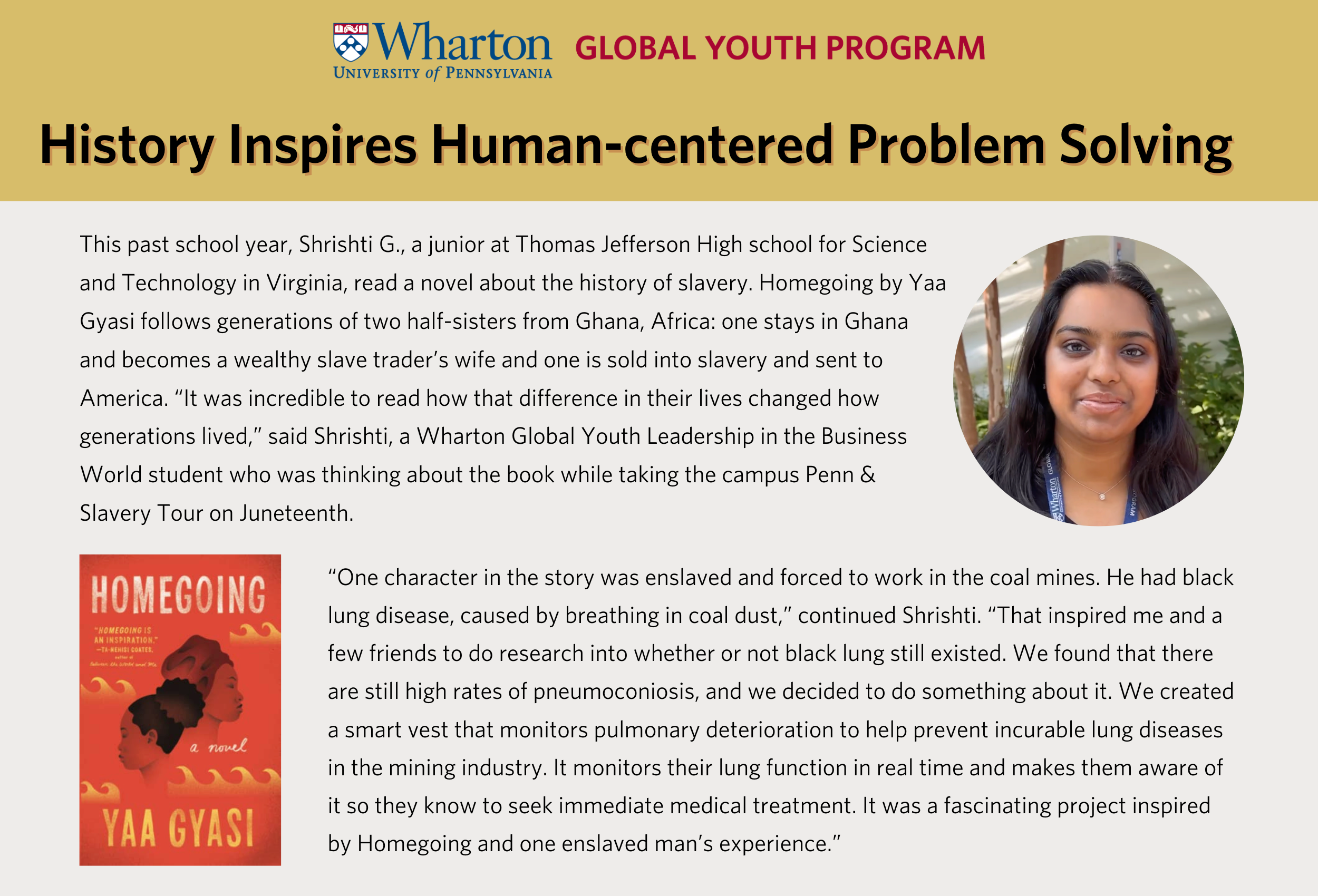Global Youth Summer Students Explore the History of Penn & Slavery


It’s a promising Monday morning at the University of Pennsylvania, complemented by a chorus of chirping sparrows and the bright sun reflecting off a statue of Benjamin Franklin, centrally located in front of College Hall.
The Philadelphia campus is uncharacteristically quiet as most students, faculty and staff enjoy an extended three-day weekend in observance of Juneteenth, the U.S. June 19 holiday commemorating the emancipation of enslaved African Americans.
By 9:00 a.m., a group of some 20 students has chatted its way down Penn’s Locust Walk to the Ben Franklin statue, where they gather in smaller groups and line benches, recounting weekend activities. They are all participants of Wharton Global Youth’s Leadership in the Business World (LBW), a three-week residential program for rising high school seniors to discover leadership in 21st Century organizations.
‘Where Slavery Hides’
Today’s immersion, however, is a departure from their daily curriculum. They are here to walk through the Penn & Slavery Project’s augmented reality campus tour, revealing Penn’s historical connection to the institution of slavery. Students visiting campus for several of Wharton Global Youth’s residential programs, also including Essentials of Entrepreneurship and Essentials of Finance, are scheduled to take the guided tour throughout the day.
This first LBW cohort shows up curious and intrigued. “I actually wanted to go on this tour before I knew that it was mandatory,” says Shrishti G., a high school student from Northern Virginia. “I want to learn more about Penn’s connection to slavery. I also think it’s a good way to learn about the campus and its history.” Adds her benchmate, Defne D.: “I’m proud of them giving us this day on Juneteenth to reflect on the history of our country and to recognize all the people who were affected by slavery.”
“Good morning!” greets the day’s tour guide, Breanna Moore, a fourth-year graduate student at Penn pursuing her Ph.D. in history. The students file in closer to the statue.

Breanna begins by providing context. “The University of Pennsylvania denied having any connection to the institution of slavery,” notes Moore, who graduated with a Penn B.A. in international relations and African studies in 2015. “Slavery was a crucial part of early-American economy, education and society. Any institution that existed during the era was impacted by slavery in some way. For this reason, in the fall of 2017 a group of undergrads under the direction of Dr. Kathleen Brown, formed the Penn & Slavery Project to study the university’s history and examine that claim…we successfully disproved that claim by identifying the ways that Penn was built on the backs of enslaved people.”
And so begins Juneteenth’s Penn & Slavery Walking Tour, which navigates to six locations on Penn’s campus that mark the school’s connection to the institution of slavery and “uncover places where slavery hides.”
LBW students pull out their phones to access the Penn & Slavery mobile app and point them at the base of the Ben statue to spawn the first AR exhibit, a combination of images and audio narration. Up pops an imagined portrait of “Caesar and the Kinnersleys,” giving way to the audio account of “Caesar’s Story.” In the late 1700s Caesar was enslaved by Penn’s first English professor, Ebenezer Kinnersley, who also served as a dormitory steward.
“Even though it was Caesar who built fires for the students and rang the school bell, Kinnersley was paid for Caesar’s labor,” notes Breanna. “The very bell that Caesar rang sits over there on the first floor of the Van Pelt Library. It speaks to the role that slavery played in Penn’s history.” Penn & Slavery Project researchers discovered that at least 75 18th Century trustees and faculty owned enslaved people.
“It’s sad and also inspiring to see that, after more than 150 years, a descendant of somebody who was enslaved by a Penn graduate was able to graduate from Penn and pursue a Ph.D.” –Sami K., LBW Student
As the group sets off for the next tour stop detailing founders and fundraising, one LBW student asks, “Why did you use AR for the tour?”
“We wanted to come up with an exhibit that wouldn’t just be like a museum exhibit where you would have to go into a building, but would be more interactive for students who attend Penn and would disrupt the way they normally understand the campus,” says Dr. Brown, the Penn professor of history who advised the Penn & Slavery Project and has joined today’s tour. “It’s like a dynamic living exhibit. Some of the history that you can’t experience directly when you’re walking around campus, you are able to access through AR.” While being on-location enriches the experience, anyone with the app can take the AR tour no matter where they are and learn about the student research that helped bring the history to light.
As we arrive at the third tour stop in Edward W. Kane Park, the group falls silent while pressing their phones to the pavement. The “Slavery’s Science” AR exhibit surrounds them in a dome featuring interactive artifacts, images and terminology that show the connections between Penn medical school professors and scientific racism. Samuel Morton, a Penn Medical School graduate, measured human skulls to support his theory that white people were superior to all other people. The Samuel George Morton Cranial Collection is stored at the Penn Museum.
“What is craniology?” asks Shrishti, as she studies the projected dome. Dr. Brown explains the scientific study of the shape and size of the skulls of different human races, as well as related concepts like polygenesis and craniometry. This, asserts the app narration, is the “strange and destructive world of scientific racism.”
A Quilt and Accountability
About an hour in – after learning about James Henry Wilson, Philadelphia’s first African American medical practitioner educated at Penn, and visiting the “Monument to Enslavers” — the group reaches the final stop on the Penn & Slavery Walking Tour at the base of the pedestrian bridge known as the Generational Bridge.
“This is the tour stop that I created for the Penn & Slavery Project,” says Breanna, adding that it highlights the social, economic and political inequalities that persist from slavery. “Through this stop, I tell the story of my fourth great grandmother and my third great grandparents who were enslaved by a Penn medical alum, Dr. William Anderson…The exhibit places my family’s quilt at the Generational Bridge, which has the bricks and engraved names of donors and alumni. This stop raises questions about whose legacies are remembered and deemed worthy of remembering. It illustrates how academia and education are formed with generational wealth and how slavery and white supremacy create a racialized gap in that wealth.”

For Sami K., a high school student from Berkeley, Calif., the AR image of the quilt and the accompanying narrative prove especially powerful. “It really hit me strongly how personal the story was,” says Sami. “It’s sad and also inspiring to see that, after more than 150 years, a descendant of somebody who was enslaved by a Penn graduate was able to graduate from Penn and pursue a Ph.D…I think it’s very important for us to do tours like this more and to systemize it so that way more people can understand the history of institutions that we look up to or that we go to. We can hold them more accountable and also hold ourselves more accountable to our history and the stories of our ancestors.”
Taking a moment to reflect, members of the Leadership in the Business World cohort are left to consider the implications of the Penn & Slavery Project on their lives as future business leaders. They rally around the importance of being critical about what you’re learning and taking the initiative to reflect on the past.
“It’s important for leaders to understand the history of these kinds of things, because it is often upheld from the top, as we have seen from the richest of the rich slave owners who contributed to this university,” says Adia D., a high school student from Morristown, N.J. “If leaders don’t understand what they could be preventing, then they won’t know how to act against it in the future.”
Knowledge of historical truths is indeed powerful, confirms Breanna, whose in-depth research of her ancestors set her on a compelling academic and personal path. “My biggest hope,” she adds, “is for the invisible to become visible.”
